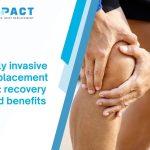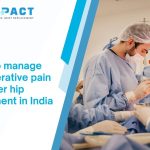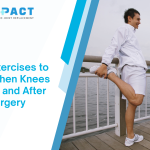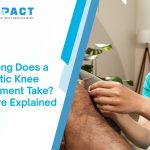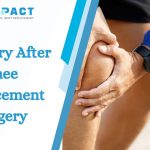you’re looking for an in-depth and personalized exploration of shoulder pain and popping when lifting your arm. This specific kind of discomfort, often accompanied by those unsettling sounds, can be incredibly frustrating and limiting. I’m here to walk you through the complexities of these symptoms, offering a comprehensive look at potential causes, diagnostic approaches, and treatment options, especially when considering Shoulder Replacement Surgery in India.
Let’s embark on this journey together, unraveling the mysteries behind your shoulder discomfort and guiding you towards understanding and potential relief. This isn’t just about symptoms; it’s about reclaiming your comfort, strength, and ability to move freely.
Decoding Your Shoulder: Understanding Pain and Popping When Lifting Your Arm at Impact Orthopedic Center
My dear friend, experiencing shoulder pain and popping when lifting your arm can be an incredibly disruptive issue. That unsettling “pop” or “click” combined with pain can make everyday tasks – reaching for something, getting dressed, or even sleeping – a real challenge. Your shoulder is a marvel of engineering, boasting the greatest range of motion of any joint in your body. But this very mobility also makes it prone to a variety of issues.
This guide is designed to be your comprehensive companion, helping you understand the intricate mechanics of your shoulder, exploring the common (and some less common) culprits behind that pain and popping, and outlining the diverse strategies for diagnosis and treatment. Our goal is to empower you with knowledge, so you can have an informed discussion with medical professionals and ultimately find the relief you deserve, particularly when seeking care at a specialized center like Impact Orthopedic Center, a leading name for Shoulder Replacement Surgery in India.
Shoulder Pain or Popping While Lifting Your Arm?
This could be due to rotator cuff injuries, labral tears, or joint issues. Early diagnosis and proper treatment can prevent long-term damage and restore mobility.
Consult an Orthopedic SpecialistThe Shoulder’s Symphony: A Brief Anatomical Overview
To truly grasp what causes shoulder pain and popping when lifting your arm, it’s essential to appreciate the complex anatomy involved:
- Bones:
- Humerus (Upper Arm Bone): The “ball” part of the ball-and-socket joint.
- Scapula (Shoulder Blade): This flat, triangular bone provides the “socket” (glenoid) for the humerus. It also has projections like the acromion (forms the roof of the shoulder) and coracoid process.
- Clavicle (Collarbone): Connects the shoulder blade to the sternum (breastbone).
- Joints:
- Glenohumeral Joint: The main ball-and-socket joint of the shoulder, allowing for wide-ranging movement.
- Acromioclavicular (AC) Joint: Where the acromion meets the clavicle.
- Sternoclavicular (SC) Joint: Where the clavicle meets the sternum.
- Scapulothoracic Joint: The articulation between the scapula and the rib cage (though not a true anatomical joint, its movement is crucial for shoulder function).
- Muscles and Tendons:
- Rotator Cuff: A group of four muscles (Supraspinatus, Infraspinatus, Teres Minor, Subscapularis) and their tendons that surround the glenohumeral joint. They provide stability and allow for arm rotation and lifting.
- Deltoid: The large muscle that gives the shoulder its rounded shape and is responsible for significant arm lifting.
- Biceps: The two-headed muscle in the upper arm, whose long head tendon runs through the shoulder joint.
- Ligaments: Strong fibrous bands that connect bones to bones, providing stability to the various shoulder joints.
- Bursae: Small, fluid-filled sacs that act as cushions between bones, tendons, and muscles, reducing friction during movement. The subacromial bursa is a common site of inflammation.
- Labrum: A rim of cartilage that deepens the glenoid socket, providing additional stability to the shoulder joint.
Shoulder Pain or Popping While Lifting Your Arm?
This could be due to rotator cuff injuries, labral tears, or joint issues. Early diagnosis and proper treatment can prevent long-term damage and restore mobility.
Consult an Orthopedic SpecialistThe Sounds and Sensations: Why Popping and Pain?
That popping or clicking sound (crepitus) you hear when lifting your arm can be unnerving. While not always indicative of a serious problem, when accompanied by pain, it’s a signal to investigate.
- Benign Crepitus: Sometimes, the popping is simply due to gas bubbles releasing in the joint fluid, or tendons moving over bony prominences. If there’s no pain associated with it, it’s usually harmless.
- Pathological Crepitus: When pain accompanies the popping, it suggests something is amiss. This could be:
- Friction: Roughened cartilage, inflamed tendons, or bursae rubbing against bone.
- Snapping: A tendon or ligament catching or slipping over a bone.
- Loose Body: A fragment of cartilage or bone floating within the joint.
- Instability: The joint moving abnormally due to stretched ligaments or a torn labrum.
Common Culprits: What Causes Your Shoulder Pain and Popping?
Let’s explore some of the most frequent reasons someone might experience shoulder pain and popping when lifting their arm:
1. Rotator Cuff Injuries (Very Common):
- Tendinitis: Inflammation of the rotator cuff tendons, often due to overuse, repetitive overhead activities, or poor posture. The tendons swell and can get pinched (impinged) under the acromion, causing pain and sometimes a grinding or popping sensation.
- Tears: Partial or complete tears in one or more of the rotator cuff tendons. This can be acute (from a fall or sudden injury) or chronic (due to degeneration over time). Tears often lead to weakness, difficulty lifting the arm, and painful clicking or popping as the torn tendon moves abnormally.
2. Shoulder Impingement Syndrome: This occurs when the rotator cuff tendons or the subacromial bursa are “pinched” between the humerus and the acromion during arm elevation. This causes pain, especially with overhead movements, and can be accompanied by popping or grinding as the inflamed structures rub. It’s often associated with rotator cuff tendinitis.
3. Labral Tears: The labrum is a ring of cartilage that surrounds the shoulder socket, helping to stabilize the joint. Tears (e.g., SLAP tears, Bankart lesions) can occur from trauma (falls, dislocations), repetitive overhead activity, or degeneration. A torn labrum can cause clicking, popping, catching sensations, and pain, especially with certain arm movements.
4. Biceps Tendinitis/Tears: The long head of the biceps tendon runs through a groove in the humerus and attaches inside the shoulder joint. Inflammation (tendinitis) or tears of this tendon can cause pain in the front of the shoulder, often radiating down the arm. Popping or snapping may occur as the inflamed or torn tendon moves within its groove.
5. Osteoarthritis (Degenerative Arthritis): “Wear and tear” arthritis can affect the glenohumeral joint or the AC joint. As the protective cartilage wears away, bone rubs against bone, leading to pain, stiffness, and a grinding or popping sensation (crepitus) with movement. This is more common in older individuals or those with a history of shoulder injury.
6. Shoulder Instability/Dislocation/Subluxation: If the ligaments around the shoulder are stretched or torn (e.g., after a dislocation), the humerus can become unstable in the socket. This can lead to recurrent partial dislocations (subluxations) or full dislocations, often accompanied by a distinct “clunk” or pop as the joint shifts, along with pain and a feeling of looseness.
7. AC Joint Separation/Arthritis: Injury to the ligaments connecting the acromion and clavicle (AC separation) can cause pain, tenderness, and a visible bump on top of the shoulder. Arthritis in the AC joint can also cause pain and popping, especially with movements that cross the arm over the body.
8. Scapular Dyskinesis (Snapping Scapula Syndrome): This refers to abnormal movement of the shoulder blade (scapula) during arm movement, often due to muscle weakness or imbalance. This can cause a noticeable popping, grinding, or snapping sensation as the scapula moves over the ribs, sometimes accompanied by pain.
9. Loose Bodies in the Joint: Fragments of cartilage or bone can break off due to injury or degeneration and float within the joint. These “loose bodies” can get caught between the joint surfaces, causing sudden sharp pain, locking, and popping sensations.
10. Less Common, But Important Considerations:
- Referred Pain: Pain from the neck (cervical radiculopathy or “pinched nerve”) can radiate to the shoulder, though usually without a popping sensation from the shoulder joint itself.
- Fractures: A fracture of the humerus, scapula, or clavicle can cause severe pain and abnormal joint movement/sounds.
- Infection or Tumor: Very rare, but can cause persistent pain and other systemic symptoms.
Shoulder Pain or Popping While Lifting Your Arm?
This could be due to rotator cuff injuries, labral tears, or joint issues. Early diagnosis and proper treatment can prevent long-term damage and restore mobility.
Consult an Orthopedic SpecialistWhen to Seek Medical Attention: Don’t Ignore the Signs
While some minor aches might resolve with rest, certain symptoms, especially the combination of shoulder pain and popping when lifting your arm, warrant prompt medical evaluation. You should definitely see a doctor, preferably at a specialized center like Impact Orthopedic Center, a leading facility for Shoulder Replacement Surgery in India, if you experience:
- Sudden, severe pain and popping after an injury or fall.
- Inability to lift your arm or a significant loss of strength.
- Obvious deformity of the shoulder joint.
- Numbness, tingling, or weakness radiating down your arm or hand.
- Persistent pain that does not improve with rest and over-the-counter pain relievers after a few days.
- Pain that worsens at night or wakes you from sleep.
- Swelling, redness, or warmth around the shoulder.
- A “locked” or “caught” sensation in your shoulder.
- Any concerns that significantly impact your daily activities or sleep.
The Diagnostic Journey: Unraveling the Cause at Impact Orthopedic Center
When you visit a medical professional, particularly at a specialized center like Impact Orthopedic Center, they will embark on a systematic diagnostic process to pinpoint the exact cause of your shoulder pain and popping when lifting your arm.
- Thorough Medical History: This is the first and often most crucial step. The doctor will ask detailed questions about:
- The onset of your pain (sudden or gradual).
- The exact location and radiation of the pain.
- The type of pain (sharp, dull, aching, burning, clicking).
- What specific movements or activities worsen or alleviate the pain and popping.
- Any associated symptoms (numbness, tingling, weakness, instability, previous injuries).
- Your occupation, hobbies (especially sports), and daily activities.
- Your general health and medications.
- Comprehensive Physical Examination: The doctor will meticulously examine your shoulder, which may include:
- Observation: Looking for any asymmetry, swelling, muscle wasting, or deformity.
- Palpation: Gently feeling for tenderness, muscle spasms, or abnormalities.
- Range of Motion Tests: Assessing your active (you move it) and passive (doctor moves it) range of motion in various directions.
- Strength Testing: Evaluating the strength of your rotator cuff and other shoulder muscles.
- Neurological Examination: Checking your reflexes, sensation, and muscle strength in your arm and hand.
- Special Orthopedic Tests: Performing specific maneuvers designed to pinpoint issues like rotator cuff tears, impingement, labral tears, or instability. The doctor might try to elicit the popping sensation to understand its origin.
- Diagnostic Imaging (If Needed):
- X-rays: Useful for visualizing bone structures, detecting fractures, bone spurs, osteoarthritis, or calcific tendinitis.
- MRI (Magnetic Resonance Imaging): Provides detailed images of soft tissues like muscles, tendons, ligaments, cartilage (including the labrum), and bursae. It’s excellent for identifying rotator cuff tears, labral tears, biceps tendon issues, and inflammation. Often the gold standard for soft tissue evaluation.
- MRI Arthrography: An MRI where contrast dye is injected into the joint before the scan, making tears in the labrum or rotator cuff even clearer.
- Ultrasound: Offers real-time visualization of tendons and muscles, useful for dynamic assessment of rotator cuff tears, tendinitis, and bursitis. It can sometimes show tendons snapping.
- CT Scan (Computed Tomography): Provides detailed cross-sectional images, particularly good for bony anatomy and sometimes used if MRI is contraindicated or for complex fractures.
Shoulder Pain or Popping While Lifting Your Arm?
This could be due to rotator cuff injuries, labral tears, or joint issues. Early diagnosis and proper treatment can prevent long-term damage and restore mobility.
Consult an Orthopedic SpecialistTreatment Approaches: A Path to Relief at Impact Orthopedic Center
Once a diagnosis is made, your medical team at Impact Orthopedic Center will devise a personalized treatment plan. The approach to shoulder pain and popping when lifting your arm is often multi-faceted, ranging from conservative measures to, in some cases, surgical intervention, including advanced procedures like Shoulder Replacement Surgery in India.
1. Conservative Management (Often the First Line of Treatment):
- Rest and Activity Modification: Temporarily avoiding activities that aggravate the pain and popping is crucial. This doesn’t mean complete immobility, but rather intelligent modification.
- Medications:
- Over-the-Counter (OTC) Pain Relievers: NSAIDs (e.g., ibuprofen, naproxen) for inflammation and pain.
- Prescription Medications: Stronger NSAIDs, or in some cases, a short course of oral corticosteroids to reduce severe inflammation.
- Physical Therapy (Physiotherapy): This is often the cornerstone of non-surgical treatment and highly effective for shoulder conditions. A skilled physical therapist will design a program to:
- Reduce pain and inflammation.
- Improve range of motion and flexibility in the shoulder.
- Strengthen weakened muscles (especially the rotator cuff and scapular stabilizers) to improve stability and mechanics.
- Improve posture and body mechanics for daily activities and sports.
- Use modalities like heat, ice, ultrasound, or electrical stimulation.
- Address any scapular dyskinesis.
- Injections:
- Corticosteroid Injections: Can be injected into the subacromial bursa (for impingement/bursitis) or into the shoulder joint (for osteoarthritis) to reduce inflammation and pain.
- Platelet-Rich Plasma (PRP) Injections: In some cases, PRP may be considered to promote healing, particularly for chronic tendinopathies.
2. Surgical Intervention (When Conservative Measures Fail):
Surgery is usually considered only after conservative treatments have been exhausted (typically 6-12 weeks or more) and if the pain is severe, persistent, or if there’s a significant structural problem (like a large rotator cuff tear, severe instability, or advanced arthritis). At Impact Orthopedic Center, surgical options are carefully considered and discussed only when truly necessary.
- Arthroscopic Shoulder Surgery (Minimally Invasive): Many shoulder conditions can be treated with arthroscopy, using small incisions and a camera. This can involve:
- Rotator Cuff Repair: To reattach torn rotator cuff tendons to the bone.
- Debridement/Decompression: Removing inflamed tissue, bone spurs (acromioplasty), or loose bodies that are causing impingement or catching.
- Labral Repair: Repairing torn cartilage around the socket.
- Biceps Tenodesis/Tenotomy: Procedures for chronic biceps tendon issues.
- Open Shoulder Surgery: For more complex or extensive repairs that require larger incisions.
- Shoulder Replacement Surgery (Arthroplasty): This is a major procedure reserved for severe cases of shoulder arthritis, extensive rotator cuff tears that are irreparable (rotator cuff tear arthropathy), or complex fractures where the joint is significantly damaged.
- Total Shoulder Replacement: Both the ball (humeral head) and the socket (glenoid) are replaced with prosthetic components.
- Reverse Total Shoulder Replacement: The ball and socket positions are reversed, which relies on the deltoid muscle for movement, typically used for patients with irreparable rotator cuff tears.
- Partial Shoulder Replacement (Hemiarthroplasty): Only the head of the humerus is replaced.
Shoulder Pain or Popping While Lifting Your Arm?
This could be due to rotator cuff injuries, labral tears, or joint issues. Early diagnosis and proper treatment can prevent long-term damage and restore mobility.
Consult an Orthopedic SpecialistImpact Ortho is a leading center for Shoulder Replacement Surgery in India. If your condition warrants this advanced procedure, you can be assured of world-class expertise, state-of-the-art facilities, and a dedicated team committed to restoring your shoulder function and alleviating your pain.
Living with and Preventing Shoulder Pain and Popping
Managing shoulder pain, especially if it’s chronic, involves a commitment to ongoing self-care and smart habits.
- Pacing Activities: Learning to balance activity and rest to avoid flare-ups. Don’t push through sharp pain.
- Good Posture: Maintaining good posture, especially when sitting or working at a computer, can significantly reduce strain on the shoulder and neck.
- Ergonomics: Optimizing your workspace, sleep position, and daily habits to support healthy shoulder mechanics.
- Regular, Gentle Exercise: Continuing a low-impact exercise program to maintain strength, flexibility, and overall shoulder health, as guided by your physical therapist.
- Warm-up and Cool-down: Always warm up before exercise or strenuous activity and cool down afterwards with gentle stretches.
- Listen to Your Body: Pay attention to early warning signs of discomfort and adjust activities accordingly.
- Seek Guidance: If you’re involved in sports or repetitive tasks, consider consulting a physical therapist or coach for technique analysis to prevent recurrence.
Shoulder Pain or Popping While Lifting Your Arm?
This could be due to rotator cuff injuries, labral tears, or joint issues. Early diagnosis and proper treatment can prevent long-term damage and restore mobility.
Consult an Orthopedic SpecialistFAQs: Your Questions About Shoulder Pain and Popping Answered
Here are some frequently asked questions that might be on your mind when dealing with shoulder pain and popping when lifting your arm, especially when looking for Shoulder Replacement Surgery in India:
Is all shoulder popping a cause for concern?
Not necessarily. If the popping is painless and happens occasionally, it’s often benign, possibly just gas bubbles releasing in the joint. However, if the popping is accompanied by pain, catching, weakness, or a feeling of instability, it warrants medical evaluation.
Can physical therapy truly fix a popping shoulder?
Yes, in many cases, physical therapy is highly effective. It can address muscle imbalances, strengthen supporting muscles (especially the rotator cuff and scapular stabilizers), improve joint mechanics, and restore proper movement patterns. For conditions like impingement, tendinitis, or mild instability, physical therapy is often the primary and most successful treatment.
What’s the main difference between a rotator cuff tear and impingement?
Impingement syndrome occurs when the rotator cuff tendons (which are usually intact) or bursa are pinched during arm movement, causing inflammation and pain. A rotator cuff tear, on the other hand, means there’s actual damage (a tear) in one or more of the rotator cuff tendons themselves, leading to weakness and often more persistent pain, especially with lifting. Impingement can sometimes lead to a tear if left untreated.
When would a doctor recommend Shoulder Replacement Surgery in India for shoulder pain and popping?
Shoulder Replacement Surgery in India (or anywhere) is typically considered when severe shoulder pain and popping are caused by advanced arthritis (where cartilage is severely worn), a massive and irreparable rotator cuff tear (rotator cuff tear arthropathy), or a complex fracture where the shoulder joint is significantly damaged and conservative treatments, including extensive physical therapy and injections, have failed to provide relief for a prolonged period. It’s a last resort for restoring function and alleviating severe pain.
How long is the recovery from shoulder surgery?
Recovery time varies significantly depending on the type of surgery. For arthroscopic procedures like rotator cuff repair, recovery can take 4-6 months to regain full function. For Shoulder Replacement Surgery in India, recovery is typically longer, often 6-12 months or more to achieve maximal improvement, involving dedicated physical therapy. Your surgeon at Impact Ortho will provide a specific timeline for your situation.
Dealing with shoulder pain and popping when lifting your arm can be a challenging experience, but understanding its potential origins is the first step towards relief. Remember, seeking professional medical advice is paramount for an accurate diagnosis and an effective, personalized treatment plan. The dedicated team at Impact Orthopedic Center stands ready to provide you with expert care, including advanced procedures like Shoulder Replacement Surgery in India, helping you regain your comfort, strength, and full range of motion. Impact Ortho is committed to being your partner on this healing journey.
Shoulder Pain or Popping While Lifting Your Arm?
This could be due to rotator cuff injuries, labral tears, or joint issues. Early diagnosis and proper treatment can prevent long-term damage and restore mobility.
Consult an Orthopedic Specialist

